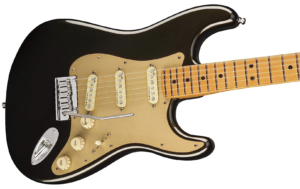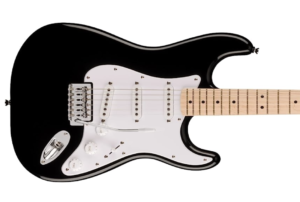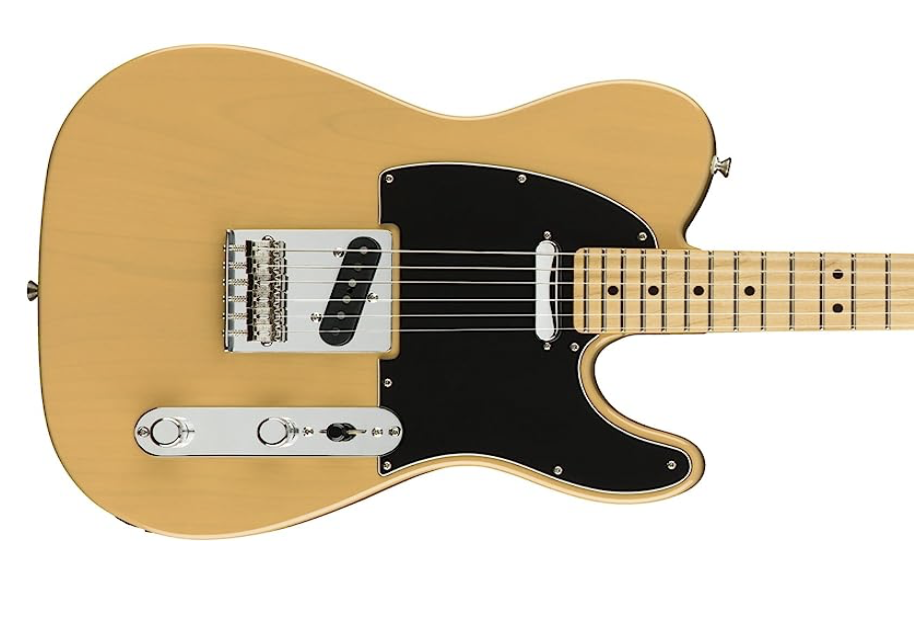When it comes to electric guitars, few names in the industry carry the weight and legacy of Fender Telecaster vs Stratocaster. Among their extensive lineup, the Telecaster and Stratocaster stand out as two iconic Fender electric guitar models that have shaped the sound of music for generations.
While both guitars have their devoted fan bases, the Telecaster and Stratocaster offer distinct characteristics, tones, and playing experiences.
In this article, I will dive into the timeless battle of the Fender Telecaster vs Stratocaster, exploring their design, sound, versatility, and notable players associated with each model. Whether you’re a guitar enthusiast or simply curious about these legendary instruments, join us as we unpack the differences and nuances between these two Fender classics.
Design of Fender Telecaster vs Stratocaster
 There are important characteristics in these Fender electric guitar models that make them very suitable for certain types of guitar players.
There are important characteristics in these Fender electric guitar models that make them very suitable for certain types of guitar players.
- Telecaster: Known for its simplicity and minimalist design, the Telecaster features a solid body with a single-cutaway shape, typically made of ash or alder. It showcases a bolt-on neck, a bridge with single-coil pickups, and a distinctive rectangular pickguard.
- Stratocaster: The Stratocaster boasts a sleek, contoured double-cutaway body, often constructed from alder, ash, or other tonewoods. It features a bolt-on neck, a tremolo bridge system, and three single-coil pickups with a five-way pickup selector switch.
Also Read:
Black stratocaster and David Gilmour
Fender Tone Master: Guitar Amp Review
Fender Acoustasonic: The Exotic Guitar That Sounds Good
8 Hot Tips to Learn The Blues Guitar
How to isolate vocals from a song
10 Important Elements of the Fender Stratocaster Design
 Here are some key features and design elements that make the Stratocaster unique:
Here are some key features and design elements that make the Stratocaster unique:
- Body Shape: The Stratocaster features a double-cutaway body shape with sleek and contoured curves. The body is typically made from tonewoods like alder, ash, or sometimes mahogany, which contribute to the guitar’s overall tone and resonance.
- Comfort Contours: The Stratocaster’s body is designed with comfort in mind. It features forearm and belly contours, allowing the guitar to sit comfortably against the player’s body during long playing sessions.
- Bolt-On Neck: The Stratocaster has a bolt-on neck construction, where the neck is attached to the body using screws. This design allows for easier maintenance and adjustments, as well as facilitating the replacement of the neck if needed.
- Neck Profile: The Stratocaster typically has a “C”-shaped neck profile, providing a comfortable grip for players of various hand sizes. The neck is usually made from maple or rosewood, offering different tonal characteristics and playing experiences.
- Fingerboard: The Stratocaster features a fingerboard (or fretboard) made from either maple or rosewood. Maple fingerboards provide a bright and snappy tone, while rosewood fingerboards offer a warmer and smoother sound. The fingerboard is adorned with dot or block inlays, providing reference points for players.
 Tremolo System: One of the defining features of the Stratocaster is its floating tremolo system, also known as the “synchronized tremolo.” This system allows players to manipulate the pitch of notes by using the tremolo arm, creating expressive vibrato effects and dive bombs.
Tremolo System: One of the defining features of the Stratocaster is its floating tremolo system, also known as the “synchronized tremolo.” This system allows players to manipulate the pitch of notes by using the tremolo arm, creating expressive vibrato effects and dive bombs.- Pickups and Pickup Switching: The Stratocaster typically has three single-coil pickups, positioned at the neck, middle, and bridge positions. These pickups contribute to the guitar’s versatile tonal options, offering clear and distinct sounds in each position. The five-way pickup selector switch allows players to access different pickup combinations for a wide range of tones.
- Control Layout: The control layout of the Stratocaster is straightforward and user-friendly. It typically includes a master volume knob, two tone knobs (one for the neck/middle pickups and one for the bridge pickup), and the five-way pickup selector switch. This setup gives players quick and easy access to tone shaping options.
- Headstock: The Stratocaster features a distinctive headstock design, often referred to as the “spaghetti” logo. The headstock is equipped with tuning machines that allow for precise tuning and stability.
- Vibrant Finish Options: Fender offers a variety of finish options for the Stratocaster, ranging from classic colors like sunburst and black to vibrant hues like red, blue, and green. The wide range of finishes allows players to choose a Stratocaster that suits their personal style and preferences.
9 Important Elements of the Fender Telecaster Design
 The design of the Fender Telecaster, often referred to as the “Tele,” is renowned for its simplicity, functionality, and timeless appeal. Here are some key features and design elements that make the Telecaster unique:
The design of the Fender Telecaster, often referred to as the “Tele,” is renowned for its simplicity, functionality, and timeless appeal. Here are some key features and design elements that make the Telecaster unique:
- Single-Cutaway Body: The Telecaster features a single-cutaway solid body design, typically made from tonewoods such as ash, alder, or sometimes pine. The body’s sleek and straightforward shape gives the Telecaster its distinctive look and comfortable feel.
- Bolt-On Neck: Similar to the Stratocaster, the Telecaster has a bolt-on neck construction. The neck is attached to the body using screws, allowing for easier maintenance and adjustments. This design also contributes to the guitar’s bright and snappy tone.
- Broadcaster/Telecaster Bridge: The Telecaster pioneered the use of the iconic “ashtray” bridge, later known as the Telecaster bridge. It consists of three brass saddles that provide individual string intonation adjustments. This bridge design contributes to the Telecaster’s unique twangy tone and sustain.
- Single-Coil Pickups: The Telecaster traditionally features two single-coil pickups, one in the bridge position and one in the neck position. These pickups, known for their clarity and brightness, deliver the signature Telecaster sound. The simplicity of the pickup configuration contributes to the guitar’s straightforward and versatile tone.
- Control Layout: The Telecaster features a straightforward control layout with two knobs and a three-way pickup selector switch. The knobs typically include a master volume and a master tone control, allowing players to shape the guitar’s sound to their preferences. The three-way switch allows for easy selection between the neck and bridge pickups, as well as a combination of both.
 Ashtray Bridge Cover: In the early days of the Telecaster, Fender included a metal “ashtray” bridge cover. Although many players remove this cover for easier access to the bridge, it remains an iconic visual element of the Telecaster’s design.
Ashtray Bridge Cover: In the early days of the Telecaster, Fender included a metal “ashtray” bridge cover. Although many players remove this cover for easier access to the bridge, it remains an iconic visual element of the Telecaster’s design.- Simple Aesthetics: The Telecaster’s design is characterized by its minimalistic aesthetics. It lacks the body contours found on guitars like the Stratocaster, giving it a clean and straightforward appearance. The simple, no-frills design has appealed to musicians seeking an instrument focused on functionality and versatility.
- Maple Neck and Fingerboard: The Telecaster typically features a maple neck with a maple or rosewood fingerboard. The combination of a bright maple neck and fingerboard contributes to the guitar’s snappy and articulate tone. The neck is often known for its comfortable “C”-shaped profile, providing a familiar and playable feel.
- Classic Finishes: Fender offers a variety of finishes for the Telecaster, ranging from classic butterscotch blonde and sunburst to vibrant colors like black, red, and white. These finishes complement the guitar’s timeless design and allow players to choose a Telecaster that suits their personal style.
Sound and Tonal Characteristics
- Telecaster: Renowned for its twangy, bright, and punchy tone, the Telecaster delivers a signature sound that is crisp and articulate. It excels in genres like country, blues, rock, and alternative music, offering a distinctive bite and clarity.
- Stratocaster: The Stratocaster offers a versatile tonal palette with its three pickups and versatile pickup configurations. From the glassy and bell-like tones of the neck pickup to the snappy and biting sounds of the bridge pickup, the Stratocaster covers a wide range of musical styles, including rock, blues, funk, and jazz.
Telecaster vs Stratocaster: Versatility and Playing Experience
- Telecaster: Loved by players seeking a straightforward and no-frills instrument, the Telecaster is often favored for its simplicity and ease of use. It offers a comfortable playing experience and straightforward controls, making it an excellent choice for both rhythm and lead guitarists.
- Stratocaster: With its ergonomic design and extensive tonal options, the Stratocaster provides players with incredible versatility. Its contoured body allows for comfortable access to higher frets, making it suitable for intricate lead playing. The tremolo system adds expressive possibilities, including vibrato and dive-bombing effects.
List of 10 Famous Telecaster Players
 Keith Richards: The iconic guitarist for The Rolling Stones is known for his energetic performances and gritty, bluesy playing style. Richards has been a longtime fan of the Telecaster and has used it extensively throughout his career, creating timeless riffs and contributing to the band’s signature sound.
Keith Richards: The iconic guitarist for The Rolling Stones is known for his energetic performances and gritty, bluesy playing style. Richards has been a longtime fan of the Telecaster and has used it extensively throughout his career, creating timeless riffs and contributing to the band’s signature sound.- Bruce Springsteen: As the “Boss,” Bruce Springsteen is synonymous with heartland rock and Americana. His Telecaster-driven anthems and soulful playing have captivated audiences for decades. Springsteen’s use of the Telecaster adds a raw and passionate element to his music.
- James Burton: Considered one of the pioneers of rock ‘n’ roll guitar, James Burton’s influential playing style and innovative use of the Telecaster have made him a legend. His precise picking, inventive solos, and signature chicken pickin’ technique have left an indelible mark on the instrument’s history.
- Albert Collins: Known as the “Master of the Telecaster,” Albert Collins was a blues guitar virtuoso. His distinctive tone, combining Telecaster’s brightness with his icy cool playing style, set him apart from other blues guitarists. Collins’ innovative use of string bending and his soulful approach made him a true Telecaster icon.
- Muddy Waters: Regarded as one of the most influential figures in blues music, Muddy Waters showcased his mastery of the Telecaster during his career. With his gritty vocals and expressive guitar playing, Waters helped define the Chicago blues sound and paved the way for generations of blues musicians.
- Joe Strummer: As the frontman of The Clash, Joe Strummer was a driving force behind the punk rock movement. Strummer’s aggressive, rebellious playing on his Telecaster added a unique edge to the band’s music, making a lasting impact on punk and rock music.
- George Harrison: As a member of The Beatles, George Harrison played a crucial role in shaping the sound of popular music. While he is often associated with his iconic Gibson guitars, Harrison also used a Telecaster on numerous recordings, contributing to the band’s diverse sonic palette.
- Jim Root: Known for his work with Slipknot and Stone Sour, Jim Root brings heavy, aggressive riffs to the Telecaster. His dynamic playing style, combined with the Telecaster’s versatility, allows Root to create a unique blend of metal and rock tones.
- Chrissie Hynde: As the frontwoman of The Pretenders, Chrissie Hynde has proven that the Telecaster is not limited to male guitarists. With her distinctive voice and driving guitar riffs, Hynde’s Telecaster playing has been an integral part of the band’s timeless rock sound.
- Mike Campbell: As Tom Petty and The Heartbreakers’ lead guitarist, Mike Campbell showcased his impeccable skills on the Telecaster. His melodic solos and tasteful playing contributed to the band’s iconic songs and cemented his status as a Telecaster maestro.
10 Famous Players Using Stratocaster Guitars
 Jimi Hendrix: Considered one of the greatest guitarists of all time, Jimi Hendrix’s innovative playing style and groundbreaking use of the Stratocaster revolutionized the world of electric guitar. His mastery of feedback, distortion, and creative approach to the instrument made him an iconic figure in rock music.
Jimi Hendrix: Considered one of the greatest guitarists of all time, Jimi Hendrix’s innovative playing style and groundbreaking use of the Stratocaster revolutionized the world of electric guitar. His mastery of feedback, distortion, and creative approach to the instrument made him an iconic figure in rock music.- Eric Clapton: Known for his soulful blues playing and remarkable tone, Eric Clapton has been a long-time Stratocaster devotee. From his early days with Cream to his solo career, Clapton’s emotive playing and signature “woman tone” have left an indelible mark on the guitar.
- Stevie Ray Vaughan: Regarded as one of the greatest blues guitarists of all time, Stevie Ray Vaughan showcased his fiery and virtuosic playing on the Stratocaster. With his lightning-fast blues licks and expressive bends, Vaughan’s Stratocaster-driven sound defined the modern Texas blues style.
- David Gilmour: As the lead guitarist of Pink Floyd, David Gilmour utilized the Stratocaster to create atmospheric and melodic guitar solos that became the hallmark of the band’s sound. Known for his soulful playing and exquisite control over tone, Gilmour’s Stratocaster work has become legendary.
- John Mayer: Known for his smooth vocals and exceptional guitar skills, John Mayer has embraced the Stratocaster as his weapon of choice. Mayer’s ability to blend blues, rock, and pop influences has made him a modern Stratocaster icon, captivating audiences with his melodic solos and tasteful playing.
 Ritchie Blackmore: As a founding member of Deep Purple and Rainbow, Ritchie Blackmore’s distinctive playing style and neo-classical approach on the Stratocaster made him a guitar legend. Known for his intricate solos and harmonic depth, Blackmore’s contributions to rock music continue to inspire guitarists worldwide.
Ritchie Blackmore: As a founding member of Deep Purple and Rainbow, Ritchie Blackmore’s distinctive playing style and neo-classical approach on the Stratocaster made him a guitar legend. Known for his intricate solos and harmonic depth, Blackmore’s contributions to rock music continue to inspire guitarists worldwide.- Buddy Guy: With his fiery blues playing and soulful voice, Buddy Guy has been a driving force in the blues genre for decades. His dynamic style, punctuated by searing Stratocaster solos and expressive bends, has made him one of the most influential guitarists in blues history.
- Jeff Beck: Renowned for his innovative and experimental approach to the guitar, Jeff Beck has pushed the boundaries of what is possible on the Stratocaster. His fusion of rock, jazz, and blues influences, coupled with his virtuosity and unique sound, have earned him critical acclaim and a devoted following.
- Mark Knopfler: As the frontman of Dire Straits, Mark Knopfler showcased his exceptional fingerstyle playing and melodic solos on the Stratocaster. His fluid and lyrical approach, combined with his storytelling songwriting, has established him as one of the most distinctive Stratocaster players in rock music.
- Bonnie Raitt: Known for her soulful voice and slide guitar prowess, Bonnie Raitt has captivated audiences with her blues-infused playing on the Stratocaster. Her ability to blend blues, rock, and folk influences has made her a highly respected and influential figure in the music industry.
Conclusion
Choosing between the Fender Telecaster vs Stratocaster ultimately depends on your personal preferences, playing style, and the musical genres you gravitate towards.
While the Telecaster offers simplicity, twang, and a timeless appeal, the Stratocaster’s versatility, comfort, and iconic sound make it a popular choice among guitarists.
Regardless of your choice, both guitars have left an indelible mark on the music industry and continue to inspire countless musicians worldwide. Whichever path you take, embrace the spirit of Fender and let your music soar.
